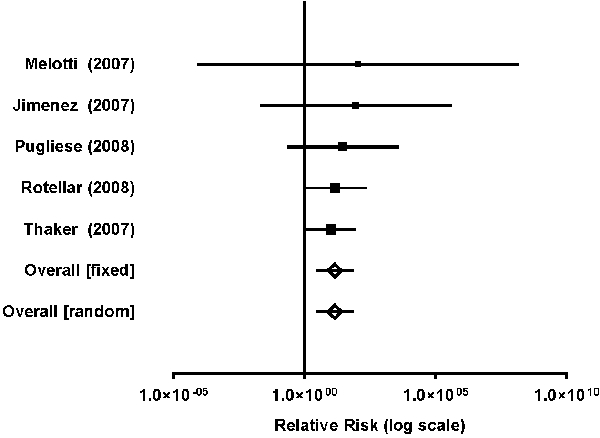|
Back to Annual Meeting Program
Bioabsorbable Staple Line Reinforcement Reduces Risk of Fistula Following Pancreatic Resection
Eric H. Jensen*1, Ming Teng2, Jessica Chowaniec2
1Surgery, University of Minnesota Medical Center, Minneapolis, MN; 2Covidien, New Haven, CT
Background: Pancreatic fistula remains a common post-surgical complication following stapled pancreatic transection. Surgical staple line reinforcement with bioabsorbable materials has grown in popularity in recent years with hopes that they may reduce pancreatic leaks. We sought to determine whether staple line reinforcement reduces risk of pancreatic fistula compared to bare metal staples.
Methods: We performed a meta-analysis of existing data regarding pancreatic fistula following stapled pancreatic transection, comparing bare metal staples to reinforced staple loads.
Results: We identified 10 manuscripts between 2007 and 2009 reporting outcomes following stapled division of the pancreas, comparing bare staples (STPL) to reinforced staples (REINF). Five retrospective reviews and 5 prospective case series were included (Table 1). A total of 483 stapled pancreatic resections are included in this meta-analysis. Of these, 234(48%) were REINF and 249(52%) were STPL. Out of 483 cases, there were a total of 100 documented pancreatic leaks (21%). Sixty-one leaks were reported out of 249 STPL divisions (24%), while 39 leaks were reported following REINF division (17%). The overall relative risk of developing a pancreatic fistula following distal pancreatectomy was not significantly different comparing STPL to REINF when all studies were combined (RR 1.00 95%CI 0.65-1.53). We further evaluated the data stratifying by study design (prospective or retrospective). In doing this, we found that prospective studies reported a significantly higher risk of pancreatic fistula with STPL compared to REINF technique (RR 14.45, 95% CI 3.15-66.21). Both fixed and random effects models for the retrospective data revealed similar RR for pancreatic fistula comparing STPL to REINF. Heterogeneity was calculated for prospective, retrospective and combined data. Prospective data had a Q-statistic of 0.44 with I2 of 0, consistent with low heterogeneity. In contrast, retrospective data had Q-statistic of 11.62 (p-value 0.02) with I2 of 66, indicative of moderate to severe heterogeneity. This is consistent with our observation that prospective studies all identified similar increased RR of leak with STPL technique, while there was conflicting data in the retrospective group. A forest plot summarizing the relative risk of pancreatic fistula for the 5 prospective studies is shown in Figure 1.
Conclusion: We have identified a significant reduction in risk of pancreatic fistula comparing reinforced to bare staples. Ideally, a randomized clinical trial should be performed to validate our observations. In the absence of that, however, reinforced staples should be the preferred method of pancreatic stump closure following distal pancreatectomy.
Table 1
| Study Type | Study (Year) | STPL Total | STPL Leaks | REINF Total | REINF Leaks | | Prospective | Rotellar (2008) | 2 | 2(100%) | 7 | 0(0%) | | Pugliese (2008) | 6 | 4(67%) | 7 | 0(0%) | | Melotti (2007) | 51 | 16(31%) | 7 | 0(0%) | | Thaker (2007) | 11 | 4(36%) | 29 | 1(3%) | | Jiminez (2007) | 18 | 7(39%) | 13 | 0(0%) | | Retrospective | Yamamoto (2009) | 25 | 5(20%) | 47 | 2(4%) | | Johnson (2009) | 44 | 7(16%) | 70 | 7(10%) | | Ferrone (2008) | 41 | 10(24%) | 45 | 15(33%) | | Guzman (2009) | 15 | 3(20%) | 15 | 11(73%) | | Laxa (2008) | 21 | 3(14%) | 9 | 3(33%) |
Summary of studies included in this meta-analysis with total number of pancreatic surgeries and pancreatic leaks identified.

Forest Plot summarizing prospective studies to date. Meta-analysis indicates significantly increased risk of pancreatic leak with bare staples (STPL) compared to reinforced staple loads (REINF).
Back to Annual Meeting Program
|


